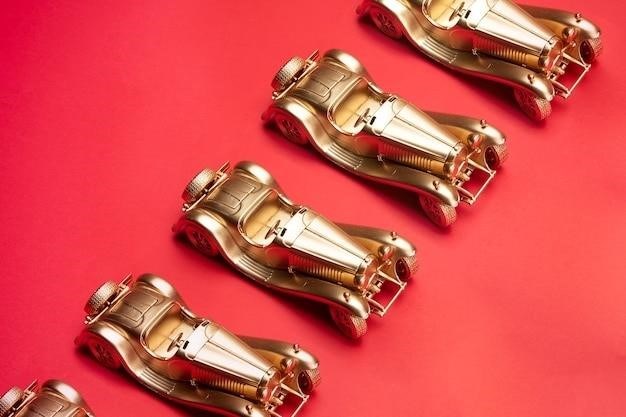Valve Guides⁚ An Overview
Valve guides are essential components in internal combustion engines, playing a crucial role in the smooth operation of valves. These cylindrical metal bushes, typically made from cast iron or bronze alloys, are pressed or integrally cast into the cylinder head. Their primary function is to provide support and guidance for the valve stem, ensuring precise movement and sealing of the combustion chamber.
Introduction
In the intricate world of internal combustion engines, where power and efficiency are paramount, the humble valve guide plays a vital role. It’s a seemingly simple component, a cylindrical metal sleeve, yet its presence is critical to the engine’s smooth operation and longevity. Valve guides serve as the guiding force for the intake and exhaust valves, ensuring their precise movement within the cylinder head. This precise movement is crucial for proper sealing of the combustion chamber, preventing the escape of combustion gases and ensuring the timely intake of fuel and air. Without these seemingly simple components, the engine would falter, losing power, efficiency, and ultimately, its ability to function.
The valve guide acts as a critical link between the valve and the cylinder head, providing a smooth and controlled path for the valve stem to travel. This controlled movement is essential for efficient combustion and exhaust processes. The valve guide’s role extends beyond simple guidance, as it also helps dissipate heat generated by the valve stem, preventing excessive temperatures that could lead to premature wear and damage. This heat dissipation is crucial for maintaining the valve’s integrity and preventing warping or distortion. The importance of valve guides is further highlighted by their impact on engine performance. Worn or damaged valve guides can lead to a range of issues, from decreased engine power and fuel efficiency to increased emissions and engine noise.
The design and materials used in valve guides have evolved over time, driven by the need to meet increasingly demanding performance requirements. As engines have become more powerful and efficient, the demands on valve guides have increased, necessitating the use of advanced materials and manufacturing techniques to ensure their durability and reliability. Understanding the importance of valve guides, their role in engine operation, and the factors that influence their design is crucial for ensuring optimal engine performance and longevity.
Importance of Valve Guides in Engine Performance
Valve guides are often overlooked, yet they play a crucial role in the performance and longevity of an internal combustion engine. Their primary function is to guide the intake and exhaust valves, ensuring their precise movement within the cylinder head. This seemingly simple task is critical for the engine’s overall efficiency and power output. The valve guides create a smooth and controlled path for the valve stem to travel, preventing any lateral movement or wobble that could lead to premature wear or damage. This precise movement is essential for proper sealing of the combustion chamber, preventing the escape of combustion gases and ensuring the timely intake of fuel and air.
Worn or damaged valve guides can significantly impact engine performance. If the valve guide is worn, the valve stem can move laterally, leading to a poor seal between the valve and the valve seat. This can result in a loss of compression, reduced power output, and increased emissions. Additionally, worn valve guides can contribute to increased friction between the valve stem and the guide, leading to increased wear and tear on both components. The consequences of a worn valve guide can be severe, ranging from decreased fuel efficiency to increased engine noise, and in extreme cases, even engine failure.
Valve guides also play a critical role in heat dissipation; The valve stem experiences high temperatures due to its proximity to the combustion chamber. The valve guide acts as a heat sink, transferring heat away from the valve stem and into the cylinder head, where it can be dissipated by the engine’s cooling system; Without this heat transfer, the valve stem could overheat, leading to premature wear, warping, or even failure. In essence, valve guides are vital for maintaining the integrity and longevity of the valve stem, ensuring optimal engine performance and efficiency.
Types of Valve Guides
Valve guides come in various materials, each with its own advantages and disadvantages, impacting their suitability for different engine applications. The two most common types are cast iron and bronze, each offering distinct properties that cater to specific needs.
Cast Iron Valve Guides
Cast iron valve guides are a popular choice due to their robust nature and affordability. They offer excellent wear resistance, making them well-suited for high-performance engines that experience significant wear and tear. Cast iron is also known for its ability to withstand high temperatures, making it ideal for exhaust valve guides that are exposed to the heat of the combustion process. The material’s inherent hardness and resistance to galling are particularly beneficial in high-load applications. However, cast iron can be prone to galling, particularly when used with stainless steel valve stems. This can lead to increased friction and wear, potentially affecting engine performance.
Bronze Valve Guides
Bronze valve guides, particularly manganese bronze, are preferred in situations where wear resistance and compatibility with different valve stem materials are paramount. They are known for their excellent lubricity, reducing friction and wear between the valve stem and the guide. This characteristic is particularly beneficial in high-performance engines, where valve stems experience significant wear and tear due to high RPMs and aggressive valve timing. Additionally, bronze valve guides are compatible with a wide range of valve stem materials, including stainless steel, which can be problematic with cast iron guides. Their inherent strength and resistance to corrosion make them ideal for demanding engine applications. However, bronze valve guides tend to be more expensive than cast iron guides.

The choice of valve guide material depends on the specific engine application and requirements. For high-performance engines, bronze valve guides often offer superior performance and longevity. In standard applications, cast iron guides provide a reliable and cost-effective option. Ultimately, the best choice depends on a balance of factors, including engine design, performance goals, and budget considerations.
Cast Iron Valve Guides
Cast iron valve guides represent a widely-used and cost-effective solution for supporting valve stems within an engine. Their robustness and resistance to wear make them suitable for numerous applications, particularly those demanding durability and affordability. The inherent strength and hardness of cast iron allow it to withstand the high temperatures and pressures encountered within the combustion chamber, making it an ideal material for exhaust valve guides, which are exposed to the intense heat of the exhaust gases.
Cast iron’s ability to resist galling, a condition where metal surfaces seize due to friction, is another key advantage. This property ensures smooth valve movement and prevents premature wear, particularly in engines operating under high loads. The material’s resistance to galling is particularly beneficial when used with steel valve stems, which are prone to galling with other materials. The material’s ability to dissipate heat efficiently helps to prevent overheating and premature failure of the valve guide.
However, cast iron valve guides are not without their drawbacks. One notable limitation is their susceptibility to galling, particularly when paired with stainless steel valve stems. This can lead to increased friction and wear, potentially affecting engine performance. Additionally, cast iron’s relatively high coefficient of friction compared to bronze can result in increased wear on both the valve guide and the valve stem.
Despite these limitations, cast iron valve guides remain a popular choice due to their affordability and durability. Their suitability for a wide range of engine applications and their ability to withstand high temperatures and pressures make them a reliable choice for many engine builders.
Bronze Valve Guides
Bronze valve guides offer a compelling alternative to cast iron, particularly in applications where wear resistance, heat dissipation, and compatibility with various valve stem materials are paramount. The superior wear characteristics of bronze make it an ideal choice for high-performance engines and those subjected to extended operating periods under demanding conditions. The material’s inherent lubricity, a measure of its ability to reduce friction, translates into smoother valve movement, minimizing wear on both the valve stem and guide.
The ability to withstand high temperatures without seizing or degrading is a significant advantage of bronze valve guides. This attribute is particularly relevant for exhaust valve guides, which are exposed to the intense heat generated during combustion. Bronze’s excellent heat dissipation capabilities help to prevent overheating, which can lead to premature valve guide failure. The material’s compatibility with a wider range of valve stem materials, including stainless steel, eliminates concerns about galling, a common issue with cast iron guides.
However, bronze valve guides come with certain drawbacks. One notable disadvantage is their higher cost compared to cast iron guides. This price difference can be a significant factor for budget-conscious engine builders. Additionally, bronze’s relatively lower strength compared to cast iron can make it more susceptible to deformation under high loads. This limitation may necessitate thicker walls for bronze guides, potentially affecting overall engine design.
Despite these considerations, bronze valve guides remain a popular choice for performance-oriented engines and those requiring high durability and extended operating life. Their exceptional wear resistance, heat dissipation, and compatibility with various valve stem materials make them a reliable solution for demanding applications.
Valve Guide Design Features
The design of valve guides is critical to their performance, ensuring optimal valve operation and longevity. Key design features influence factors like wear resistance, heat dissipation, and overall engine performance. The most notable feature is the guide’s inner diameter, which must maintain a precise clearance with the valve stem. This clearance, known as the valve guide-to-stem clearance, is crucial for smooth valve movement and proper sealing. Too tight a clearance can lead to excessive friction and wear, while too loose a clearance can result in valve stem instability and poor sealing.
Valve guides often incorporate features designed to enhance their functionality and reliability. One common design element is a chamfer at the top of the guide, which helps to prevent the valve stem from binding as it enters the guide. Another feature, particularly in high-performance applications, is the inclusion of a lubrication groove or oil hole. These features facilitate oil lubrication to the valve stem, reducing friction and wear. The guide’s length is also an important design consideration, as it influences valve stem stability and heat dissipation. Longer guides offer greater stability, but they can also hinder heat transfer from the valve stem to the cylinder head.
In addition to these basic features, valve guides can incorporate more specialized designs to address specific performance demands. For example, some guides feature a tapered bore, which helps to maintain a consistent clearance between the guide and the valve stem throughout the valve’s travel. Other designs incorporate a recess at the bottom of the guide, which allows for the use of a valve stem seal to prevent oil leakage from the cylinder head. The choice of valve guide design depends on a variety of factors, including engine type, operating conditions, and performance goals. Carefully considering these factors during engine design and rebuild can help ensure optimal valve operation and overall engine performance.
Installation and Maintenance
Installing valve guides requires precision and care to ensure proper fit and function. The installation process typically involves pressing the guide into the cylinder head, ensuring a tight and secure fit. This is often done using a specialized hydraulic press, which applies even pressure to the guide, preventing distortion or damage. Proper alignment is crucial during installation to guarantee the valve stem moves smoothly and without binding within the guide.
Maintaining valve guides is essential for preserving engine performance and preventing premature wear. Regular inspection for wear and tear is a vital part of engine maintenance. Excessive wear can lead to increased friction, valve stem instability, and ultimately, valve failure. If wear is detected, the guide may need to be replaced. Valve guide replacement is a more complex procedure than simple inspection and often requires specialized tools and expertise.
In some cases, valve guides can be honed to restore their original diameter and improve their performance. Honing is a process that uses a specialized tool to smooth and refine the guide’s inner surface, removing any burrs or irregularities. This can help to reduce friction and improve valve stem movement. Regular engine oil changes are also important for maintaining valve guide performance. Engine oil lubricates the valve stem and guides, reducing wear and tear. Using high-quality engine oil formulated for the specific engine type can help extend valve guide life and prevent premature wear.
Troubleshooting Valve Guide Issues
Identifying valve guide problems often involves recognizing specific symptoms that indicate issues with the valve train. One common sign is excessive valve noise, which can manifest as a ticking or tapping sound coming from the engine. This noise is usually caused by increased friction between the valve stem and the guide, often due to wear or misalignment. Another symptom can be a loss of engine power or a decrease in fuel efficiency. This can be caused by a variety of factors, but worn valve guides can restrict valve movement, leading to inefficient combustion and reduced engine power.
A telltale sign of a worn valve guide is excessive oil consumption. Worn guides can allow oil to leak past the valve stem seals, entering the combustion chamber and burning off. This can lead to a noticeable increase in oil consumption, especially during high engine loads. Additionally, blue smoke coming from the exhaust is a strong indicator of oil consumption, often associated with worn valve guides.
Diagnosing valve guide problems typically involves a visual inspection of the valve guides and valve stems. This can be done by removing the cylinder head and inspecting the components for wear, damage, or misalignment. A mechanic may also use specialized tools to measure the clearance between the valve stem and the guide. In some cases, a leakdown test can be performed to assess the sealing efficiency of the valve train, which can help pinpoint problems with the valve guides.







